Michelle: Welcome everyone. I truly hope that this webinar's helpful to you, and ultimately, to the clients that you serve or will serve in the future. Today, we are going to be addressing wheelchair positioning but looking at this in a little different way. We are primarily going to be looking at positioning outside of the wheelchair for people who traditionally use a wheelchair seating system. This is looking at the entire 24-hour position of our clients. A big portion of today's talk is sleep positioning. We know that positioning is really important, and there are quite a few recorded webinars within the occupationaltherapy/physicaltherapy.com libraries all about positioning within the wheelchair.
Importance of Positioning
There are a lot of people we work with who cannot change their body position independently. This could be for a variety of reasons such as weakness, tone, paralysis, coordination, balance, and these sort of issues. As a result, the client may sit or lie down in a more destructive posture and not be able to move outside of that position independently. So, we bring in a wheelchair seating system to compensate for these issues to help support the client in an identified optimal position and maintain that position for the client who cannot otherwise achieve or maintain that position on their own. The position is not just to look pretty, but it is also to help this person be as functional as possible. Although we may put a tremendous amount of work into designing the very best seating system for someone, our clients may not really spend that much time in it. Even if they spend quite a bit of time in a seating system, it is usually a fairly small percentage of a 24 hour period, and that is a lot of time.
A 24 Hour Approach
Our clients do not spend, or should not spend, 24 hours a day in their wheelchair seating system. I have had a few, but that is not our goal. We need to look at all the positions our client might be in. Particularly in pediatrics, we use alternative seating systems, apart from the wheelchair base, like standers and sidelyers. A common alternative position is bed, and our clients can spend quite a bit of time in bed. We are typically only in bed to sleep, and many of us do not always get the number of hours of sleep that we would like. On the other hand, many of our clients often use that bed as an alternative positioning system. They may also use it to nap or rest during the day. Dressing, diaper changes, sometimes even feeding, if someone is tube fed, for example, may occur in bed. Now, out of that 24 hours, we have a client who might be spending half of their time in bed. Thus, it is really important that we evaluate the position of the client in bed to make sure it is working for them.
Example
Let's look at a quick example. Let's say that a child with cerebral palsy receives their seating system for their wheelchair to maintain that optimal position. We have done an evaluation, written the letters of medical necessity, and have received funding approval. Now, this child has the best seating system they possibly could get, but they might only spend six hours a day in their seat. And as you know, for a child, that is a lot of hours as it is. They spend the other 18 hours a day in other positions, such as a stander like this pictured here in Figure 1, but also in bed. We have to look at all those positions.
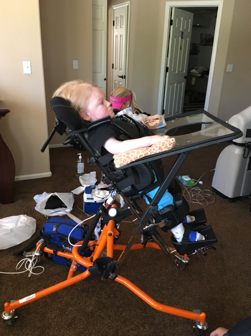
Figure 1. Stander.
This same child may continue to demonstrate changes. They might be losing range and have orthopedic changes in the hips and the spine. It is easy to say, "It must be the seating system. I guess we have to start over, modify, or change the seating system." However, it might be that those other 18 hours are the actual problem. If those hours are being spent in a less than optimal position, sometimes called a destructive posture, then we need to address that or we are going to continue to see these negative consequences for our clients.
Terminology
Let's talk terminology for a minute. The 24 hour positioning approach explores all the positions a client is in, day and night. Again, this includes a wheelchair, alternative seating systems, standers, bed, et cetera. Sleep positioning, sometimes called nighttime positioning, looks specifically at positioning while the client is in bed. Postural care is another word that is sometimes used to describe either of these terms. It might refer to looking at all positions throughout 24 hours, and more commonly, it is used to refer to sleep positioning.
Case Study #1
Before we dive into some of our specific goals and interventions for sleep positioning, I wanted to start with a case study so we have some context about what we are talking about. This information is going to apply to a wide variety of client diagnoses and ages so keep that in mind. We are going to use Brady as a starting point.
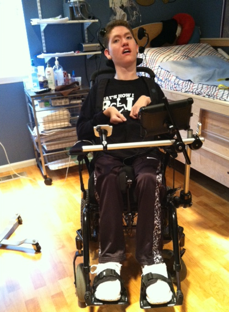
Figure 2. Brady.
I have worked with Brady since he was about six years old. At the time of this evaluation, Brady was 15. He has cerebral palsy, and he is using a custom-molded seating system to support him in this position. His wheelchair is a tilt in space manual wheelchair. During one of our follow-ups when we were looking at his wheelchair seating system, I noticed that Brady was starting to develop something called a windswept tendency in his legs. This looks like the wind has come along and blown the legs to one side. One of his legs was adducted and internally rotated, while the other was abducted and externally rotated. This is commonly seen in people with increased muscle tone who are using wheelchair seating systems. A common cause of this windswept tendency is sleep positioning. So, we took him out of his chair and put him to bed. I asked mom to show me how she typically positions him in bed.
Figure 3 shows Brady's sleep position.
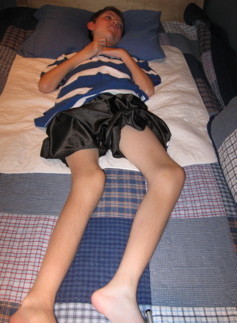
Figure 3. Brady's position in bed.
He is laying on top of his covers. Many of our clients sleep on their back as they tend to lose hip and knee extension because the hips and knees are flexed so much of the day. By the way, this is one of the important reasons to look at alternative positioning. It is also an important reason to include standing as a part of someone's interventions when we can and when it is appropriate to maintain hip and knee extension. Brady has lost some hip and knee flexion. It is not terrible, but it is impossible for him to lay on his back with his legs completely straight in front of him. His legs either fall to one side, which they have fallen to his left side or they fall to either side with both legs abducted. If you look at Figure 3, the left leg is abducted at the hip and externally rotated, and the right leg is adducted and internally rotated creating that windswept tendency.
Now, for you and I, we assume all sorts of postures during the night. Maybe not as much as when you were a kid, as kids make a lot of positional changes during the night, but even as adults, we tend to move around. So, if we are in an asymmetrical position for a short time, it is not too problematic. Where the problem develops is when someone like Brady is put to bed in this position, and he stays there for the next eight hours as he is not able to move. This is when we start to see changes occur in the body.
What we decided to do as a temporary solution was use a VersaForm pillow. It is similar to a beanbag and has a valve on it to suck out the air. By sucking out the air, the beads come close together, and it gets hard and maintains its shape. We added this pillow under Brady's legs as shown in Figure 4.
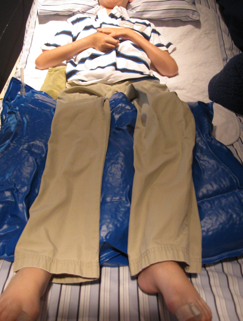
Figure 4. Brady using VersaForm pillow.
His legs are each sitting in this pillow, and it forms a trough. This position is also respecting his range limitation in his hips and knees. We are maintaining him in a little bit of flexion at the hips and knees, and that allows us to align his legs. Instead of them falling to the side, they are now in front of him. If you compare Figure 3 and 4, you can see the difference. From the side, you can see that he is not in a lot of flexion (Figure 5).
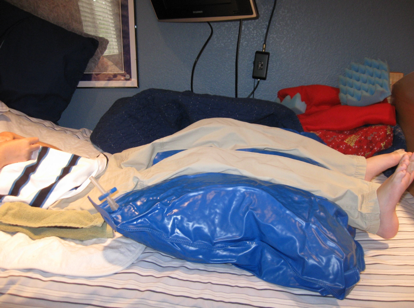
Figure 5. Side view of the VersaForm pillow.
It is important that we maintain some of that hip and knee extension that he still has. We do not want him to continue to lose range, but we need to accommodate the range loss he has. We also want to make sure his heels are off the mattress because that could be a pressure concern.
This VersaForm is just a temporary solution. It tends to be rather hard, and it does not hold its position forever. We came up with a more permanent solution for him after we played around with this. You can see with his legs out that the troughs that his legs were in were actually quite deep and quite narrow because he is quite thin, and we needed to give good contact to the side of his legs to maintain neutral rotation.
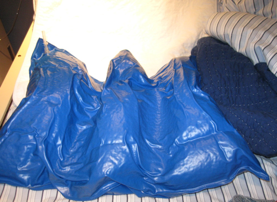
Figure 6. VersaForm.
It was not as hard to keep his legs from being adducted or abducted but to control that tendency of rotation, we had to make sure those troughs were rather narrow to hold his legs in neutral rotation. We eventually fabricated a more permanent foam version of this. But for evaluation and trial, the VersaForm worked quite well.
We also needed to address this issue in his wheelchair. In Figure 7, you can again see that Brady again has a tendency towards a windswept posture. His left leg wants to abduct and rotate and his right leg wants to adduct.
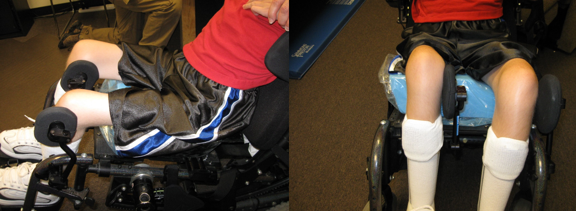
Figure 7. Brady in a wheelchair.
We placed a pad to the medial side of the right knee to prevent excessive adduction. And on the lateral side of the left leg, we added a pad to prevent excessive abduction. This allowed us to keep him in neutral alignment during those hours that he was sitting in the chair as well. In the right picture, the cushion he is on is a template. We were molding him this day for a semi-custom cushion from Ride Designs, and he is sitting on the base that is used to capture his shape. Fortunately, with Brady, we were able to capture these changes early and intervene. After several months of using the sleep positioning equipment, as well as the changes to his wheelchair seating, Brady regained the lost range that he had for adduction and abduction, as well as rotation. We could easily get him into neutral. He still uses the sleep positioning system because he still does not have full extension in his hips and knees, and his legs would continue to fall to that side. He also still has the support he needs in the wheelchair to prevent him from redeveloping this issue.
Goals of Sleep Positioning
- To improve the quality and duration of sleep
- To promote health and maintain safety during sleep
- To minimize, prevent or even reverse orthopedic changes
Our goals of positioning someone in sleep include improving the quality and duration of sleep, promoting health and maintaining safety during sleep, and to minimizing, preventing, or even reversing orthopedic changes. These are goals that make sense to us as clinicians, and I think caregivers get very excited about these as well.
Quality and Duration of Sleep
Many people with disabilities have difficulty sleeping. This could be for a lot of different reasons. It might be that the client cannot change their position at all and so they get quite uncomfortable as a result. It might be due to muscle tone and movement patterns that are interfering with sleep. It could be even difficulties with breathing, swallowing, and reflux. This tends to lead to sleep deprivation for the client and their caregivers. If any of you are parents, think back to when you had a newborn at home. Every two hours, and sometimes more, you were up caring for your child. There is no one as sleepy as the parent of a newborn, except maybe the caregiver of someone who is having difficulty sleeping at night. Many of the clients that I see have sleep deprived caregivers. And when we bring in sleep positioning options, oftentimes client will suddenly start sleeping longer and sleeping better. That means that their caregivers are my new BFFs. They love me, and they love postural care because they can start sleeping again.
We know a lot of important things happen during sleep as well. Restorative sleep is essential for everybody. When we are not getting enough sleep, bad things happen. We do not function as well. Specifically for people who have physical disabilities, restorative sleep is when soft tissue repair occurs. Our clients are more likely than the average person to develop trauma to their soft tissues, and those repairs happen during the night. Also, our immune systems work better when we are getting enough sleep. A compromised immune system can cause illness. We also know that research shows that in children, most growth occurs at night during sleep. And if we get enough sleep, our cognitive and physical performance is improved.
Health and Safety
There are many clients who need quite a bit of attention at night to keep them safe. This can be for a variety of reasons. Many of the clients who require sleep positioning have reflux issues and are at risk for aspiration. These clients might already be using a bed where the head of the bed is raised to try to address this, but sometimes there is more positioning that needs to occur to help prevent this aspiration risk.
Clients can also be at risk of entanglement or entrapment. I worked at The Children's Hospital of Denver in an assistive technology program for many years. We had one of the first sleep positioning programs in the country there. It was very hard to convince the hospital to let us open this program. Finally, a group of us sat down and wrote down all the children we had worked with over the previous 10 years that we knew that had died during sleep, and we felt could have been prevented. We came up with about a dozen names to support our case. There are too many clients who get entrapped between a mattress and a wall, a mattress, and a side rail or get entangled in covers, pillows, et cetera. Clients may have a lot of movement during the night but not a lot of control or the ability to turn their face away from the surface of a mattress or pillow. Thus, health and safety are important goals of sleep positioning.
